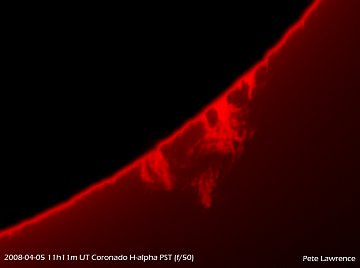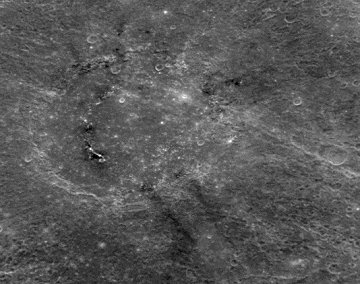| Where's Saturn? Is that a UFO--or the ISS? What's the name of that star? Get the answers from mySKY--a fun new astronomy helper from Meade. | |  | AURORA WATCH: A solar wind stream is buffeting Earth's magnetic field and causing intermittent geomagnetic storms. Northern sky watchers should be alert for auroras tonight: gallery. SOLAR ACTIVITY: Together, sunspot 988 and a long magnetic filament are rounding the sun's western limb, but instead of disappearing "they are putting on quite a show," reports Pete Lawrence of Selsey, UK. "As the filament moves off the surface it turns from a dark filament into a bright prominence." Here is the view through his Personal Solar Telescope: 
Readers with solar telescopes should keep an eye on the sun's western horizon. The filament is more than 100,000 miles long and could continue its display throughout the weekend. more images: from John Stetson of Falmouth, Maine; from Peter Paice of Belfast, Northern Ireland; from Robert Arnold on the Isle of Skye, Scotland; from Andy Tennant of Edinburgh, Scotland; DARK MOZART: NASA's MESSENGER spacecraft has beamed back a new photo of Mozart, but it doesn't look much like Amadeus: 
This is the Mozart, the crater. MESSENGER took the picture on January 14th during the spacecraft's historic flyby of Mercury. On that planet craters are named for people who have made important contributions to the arts--e.g., Mozart, Vivaldi, Matisse and others. Crater Mozart was christened in the 1970s after its discovery by Mariner 10, the first spacecraft to visit Mercury. MESSENGER's new picture of Mozart shows something Mariner 10 missed: strange dark markings on the crater floor and dark rays shooting across the crater's upthrust rims. What is this material? No one knows, but it is probably kin to the mysterious dark halos found around other craters in nearby Caloris Basin. Spectral data gathered by Messenger and being analyzed now by mission scientists may yet reveal Mozart's composition.
March 2008 Aurora Gallery
[Aurora Alerts] [Night-sky Cameras] | 
